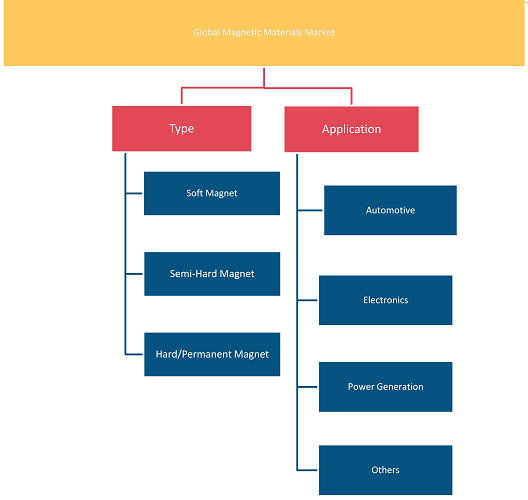MARKTÜBERSICHT
Magnetische Materialien sind Substanzen, die von einem Magneten angezogen werden, wenn ein externes Magnetfeld an sie angelegt wird. Magnetische Materialien werden im angelegten Magnetfeld magnetisiert, weil sie magnetische Momente induzieren. Der Magnetismus entsteht aus dem magnetischen Moment der magnetischen Materialien. Eisen, Kobalt, Nickel, Neodym und Samarium-Kobalt sind die fünf am häufigsten verwendeten magnetischen Materialien, da sie günstige magnetische Eigenschaften aufweisen. Das Verhalten des Magnetismus in Materialien hängt eng mit den Eigenschaften ihrer Atombestandteile zusammen, insbesondere mit dem Verhalten ihrer Elektronen. Der Markt für Home-Entertainment-Produkte ist auf magnetische Materialien in Anwendungen wie Lautsprechern, CD-Playern, Fernsehern, PCs und Spielekonsolen angewiesen. Darüber hinaus wird die steigende Nachfrage nach elektronischen Geräten wie Tablets, Smartphones, Laptops und Fernsehern das Gesamtwachstum der Branche ankurbeln.
MARKET DYNAMICS
Der Markt für magnetische Materialien wird im Prognosezeitraum voraussichtlich deutlich wachsen. Das Wachstum ist auf die zunehmende Anwendung im Automobilsektor zurückzuführen. Magnetische Materialien, einschließlich Materialien, die in Servolenkungssystemen, Elektromotoren, Sensoren und Aktoren verwendet werden, sind in verschiedenen Automobilanwendungen von entscheidender Bedeutung. Die Nachfrage nach Elektro- und Hybridfahrzeugen steigt stetig, was wiederum die Nachfrage nach Permanentmagneten steigert. Permanentmagnete werden in Windkraftanlagen zur Stromerzeugung eingesetzt, während magnetische Elemente in Wechselrichtern, Solarmodulen und Energiespeichersystemen eingesetzt werden. Der Ausbau erneuerbarer Energieanlagen dürfte die Nachfrage nach magnetischen Werkstoffprodukten in den kommenden Jahren steigern. Viele Unternehmen verlagern ihren Fokus auf die Entwicklung neuer und innovativer Produkte auf dem Markt für magnetische Materialien. Die steigende Nachfrage nach magnetischen Materialien treibt aufgrund des technologischen Fortschritts die Eigenschaften und neuen Anwendungen voran. Allerdings sind die Kosten für magnetische Rohstoffe, Herstellung und Verarbeitung hoch, was das Wachstum behindern kann.
MARKTUMFANG UND BERICHTSMERKMALE
Die „Globale Marktanalyse für magnetische Materialien bis 2030“ ist eine spezialisierte und tiefgreifende Studie mit einem Schwerpunkt auf den globalen Markttrends und Wachstumschancen. Ziel des Berichts ist es, einen Überblick über den globalen Markt mit detaillierter Marktsegmentierung nach Typ, Anwendung und Geografie zu geben. Der globale Markt für magnetische Materialien verzeichnete in der jüngsten Vergangenheit ein starkes Wachstum und es wird erwartet, dass dieser Trend im Prognosezeitraum anhält. Der Bericht liefert wichtige Statistiken zum weltweiten Verbrauch magnetischer Materialien sowie zu deren Nachfrage in wichtigen Regionen und Ländern. Darüber hinaus bietet der Bericht eine qualitative Bewertung verschiedener Faktoren, die die Leistung des Marktes für magnetische Materialien in wichtigen Regionen und Ländern beeinflussen. Der Bericht enthält auch eine umfassende Analyse der führenden Akteure auf dem Markt für magnetische Materialien und ihrer wichtigsten strategischen Entwicklungen. Darüber hinaus sind mehrere Analysen zur Marktdynamik enthalten, um die wichtigsten treibenden Faktoren, Markttrends und lukrativen Möglichkeiten zu identifizieren, die wiederum bei der Identifizierung der wichtigsten Einnahmequellen helfen würden.
Darüber hinaus bieten die Ökosystemanalyse und die Fünf-Kräfte-Analyse von Porter einen 360-Grad-Blick auf den globalen Markt für magnetische Materialien, der zum Verständnis beiträgt die gesamte Lieferkette und verschiedene Faktoren, die das Marktwachstum beeinflussen.

SEGMENTALE ANALYSE
Der globale Markt für magnetische Materialien ist nach Typ und Anwendung segmentiert. Je nach Typ wird der Markt für magnetische Materialien in Weichmagnete, Halbhartmagnete und Hart-/Permanentmagnete unterteilt. Auf der Grundlage der Anwendung wird der Markt in Automobil, Elektronik, Energieerzeugung und andere eingeteilt.
Bezogen auf den Typ macht das Segment der Halbhartmagnete einen erheblichen Anteil aus, was auf seine häufige Verwendung in magnetischen Materialanwendungen zurückzuführen ist. Magnetisch gesehen fallen die halbharten Materialien hinsichtlich der Koerzitivfeldstärke in die Kategorie zwischen weichmagnetischen und permanentmagnetischen Materialien. Bei der magnetischen Aufzeichnung wird halbhartes Material entweder in Partikel- oder Dünnfilmform zu Band- oder Plattenmedien verarbeitet. Halbhartmagnetische Materialien funktionieren gut in Geräten wie hysteresegekoppelten Antrieben, Bremssystemen und Kompassen. Sie sind so konzipiert, dass sie über spezifische magnetische Eigenschaften verfügen, die für verschiedene Anwendungen geeignet sind, bei denen niedrige Koerzitivfeldstärke, hohe Permeabilität und minimale Verluste erwünscht sind. Die Kombination dieser Eigenschaften macht Weichmagnetmaterialien jedoch für eine Vielzahl von Anwendungen äußerst wünschenswert, darunter Transformatoren, Induktoren, Magnetsensoren, Elektromotoren, Generatoren und andere elektromagnetische Geräte, bei denen eine effiziente Energieumwandlung und minimale Verluste unerlässlich sind.
REGIONALE EINBLICKE
Der Bericht bietet einen detaillierten Überblick über den globalen Markt für magnetische Materialien in Bezug auf fünf Hauptregionen, nämlich Norden Amerika, Europa, Asien-Pazifik (APAC), Naher Osten und Afrika (MEA) sowie Süd- und Afrika. Zentralamerika. Es wird geschätzt, dass der asiatisch-pazifische Raum einen erheblichen Marktanteil ausmacht. Insbesondere China und Indien verfügen über hochentwickelte Stromerzeugungssektoren und haben erhebliche Investitionen in die Elektronik- und Automobilindustrie getätigt. Der Fortschritt in diesem Sektor hat zu einer erhöhten Nachfrage nach magnetischen Materialien geführt, die wesentliche Komponenten in verschiedenen Anwendungen sind, darunter Energieerzeugung, Elektronik und Automobilsysteme. Die Region Asien-Pazifik ist mit zunehmenden Umweltproblemen im Zusammenhang mit Luftverschmutzung und Kohlenstoffemissionen konfrontiert. Um Sonnen- oder Windenergie in elektrische Energie umzuwandeln, werden magnetische Wandler benötigt. Daher ist die kontinuierliche Entwicklung der erneuerbaren Energiesektoren im asiatisch-pazifischen Raum ein Anstoß, um den Markt für magnetische Materialien voranzutreiben.
MARKTSPIELER
Zu den wichtigsten Akteuren auf dem Markt für magnetische Materialien gehören Daido Steel Co Ltd, Dexter Magnetic Technologies, Dura Magnetics, Kaiven Magnet Co, Lynas Corporation Ltd, Molycorp Magnequench, Shin-Etsu Chemical Co Ltd, TDK Corp und Toshiba Unter anderem Materials Co Ltd, FJ Industries A/S, Arnold Magnetic Technologies und Hitachi Metals, Ltd.
Das engagierte Forschungs- und Analyseteam des Insight Partners besteht aus erfahrenen Fachleuten mit fortgeschrittener Statistikkompetenz und bietet verschiedene Anpassungsmöglichkeiten in der bestehenden Studie.
- Historische Analyse (2 Jahre), Basisjahr, Prognose (7 Jahre) mit CAGR
- PEST- und SWOT-Analyse
- Marktgröße Wert/Volumen – Global, Regional, Land
- Branchen- und Wettbewerbslandschaft
- Excel-Datensatz
Aktuelle Berichte
Erfahrungsberichte
Grund zum Kauf
- Fundierte Entscheidungsfindung
- Marktdynamik verstehen
- Wettbewerbsanalyse
- Kundeneinblicke
- Marktprognosen
- Risikominimierung
- Strategische Planung
- Investitionsbegründung
- Identifizierung neuer Märkte
- Verbesserung von Marketingstrategien
- Steigerung der Betriebseffizienz
- Anpassung an regulatorische Trends






















 Kostenlose Probe anfordern für - Markt für magnetische Materialien
Kostenlose Probe anfordern für - Markt für magnetische Materialien